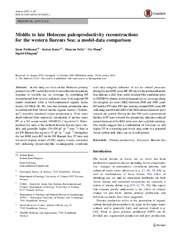Middle to late Holocene paleoproductivity reconstructions for the western Barents Sea: a model-data comparison
Permanent link
https://hdl.handle.net/10037/9022Date
2015-11-30Type
Journal articleTidsskriftartikkel
Peer reviewed
Abstract
In this study we focus on late Holocene primary
productivity (PP) variability in the western Barents Sea and its
response to variable sea ice coverage by combining PP
reconstructed from several sediment cores with regional PP
trends simulated with a well-constrained organic facies
model, OF-Mod 3D. We find that modern production rates
reconstructed from buried marine organic matter (‘‘bottomup’’)
resemble simulated export production at 50 m water
depth inferred from numerical simulations of surface water
PP in a 3D ocean model, SINMOD (‘‘top-down’’). Paleoproductivity
rates in the northern Barents Sea are more variable
and generally higher (30–150 gC m-2 year-1
) than in
the SW Barents Sea region (\75 gC m-2 year-1
) throughout
the last 6000 years BP. In the SW Barents Sea, PP rates and
terrestrial organic matter (TOM) supply remain constantly
low indicating present-day-like oceanographic conditions with only marginal influence of sea ice related processes
during the last 6000 years BP. PP rates in the northern Barents
Sea indicate a shift from stable modern-like conditions prior
to 2800 BP to denser, more permanent sea ice coverage along
the marginal ice zone (MIZ) between 2800 and 1000 years
BP and low PP rates. PP rates increase around 1000 years BP
indicating a northward shift of the MIZ and accelerated export
towards the seabed. During the last 500 years a pronounced
decline in PP rates towards the present day indicates reduced
annual duration of the MIZ in the area due to global warming.
Our results suggest that a combination of first-year ice and
higher PP in a warming pan-Arctic may point to a potential
Arctic carbon sink while sea ice is still present.
Description
Published version also available at http://dx.doi.org/10.1007/s41063-015-0002-z


 English
English norsk
norsk